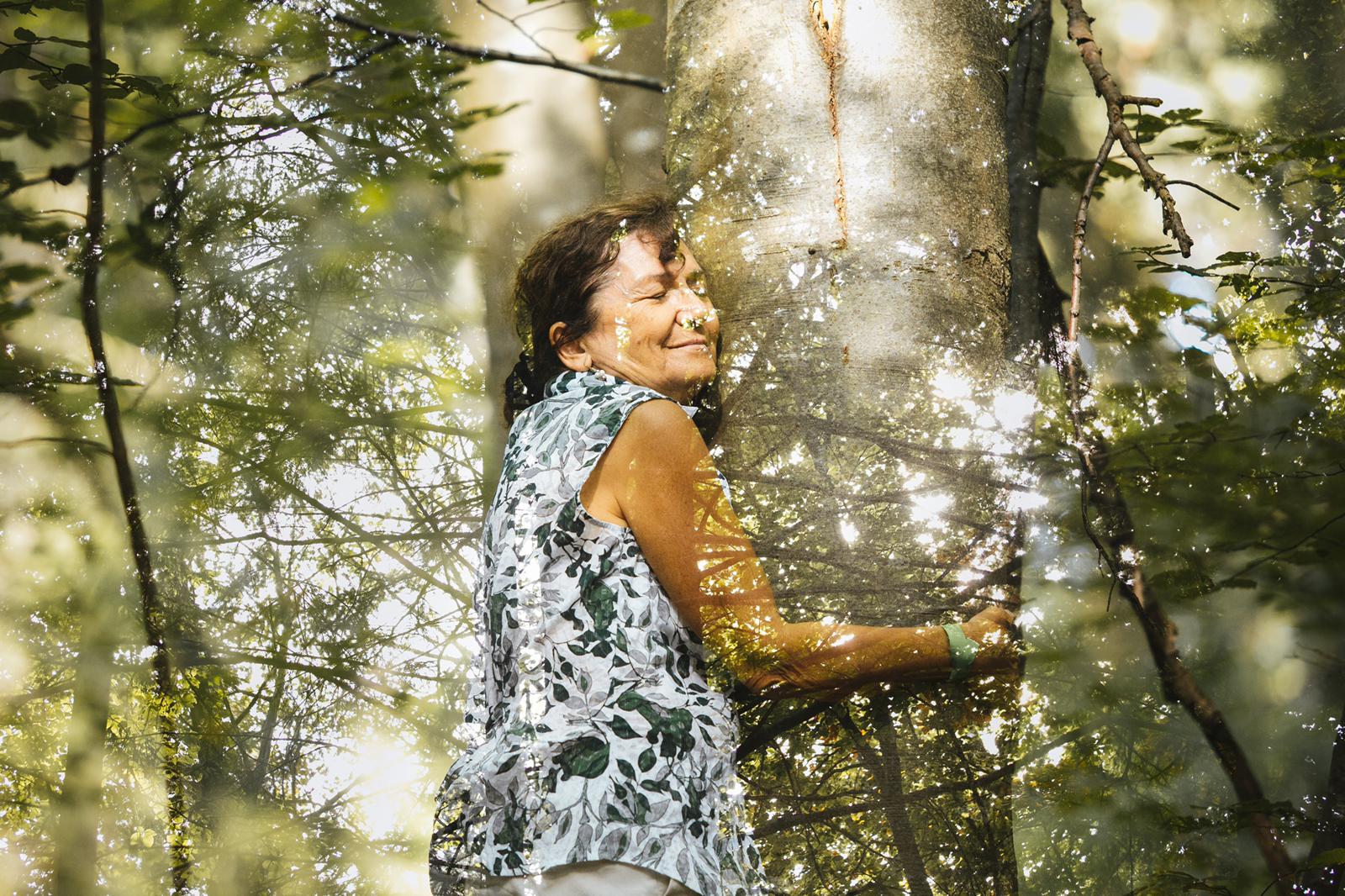FOREST BATHING
FOREST IMMERSION
Forest bathing is a practice that was born in Japan with the name of “Shinrin Yoku” and is very popular in the Far East, where it plays a key role in preventive medicine.
Several scientific studies conducted in Japan and South Korea have demonstrated that monoterpenes (or “Phytoncides”), which are volatile substances components of essential oils released by different species of trees, if inhaled in sufficient doses and for an adequate period of time can induce enduring physiological changes in the human body. This includes stress reduction, lower blood pressure, and enhanced immune system response.
The practice consists in walking in the forest on consecutive days, in order to breath for several hours the air naturally enriched with the therapeutic volatile substances emitted by trees.
Within Parco del Respiro in Fai della Paganella the forest areas with the greatest potential to emit beneficial volatile substances (the monoterpenes) are those with a predominance of beech trees. Most of the path Sentiero dei Reti runs through this type of forest, often mixed with European spruce and Scots pine. This trail joins the path Acqua e Faggi, which entirely crosses a beech forest, and then it extends northward to the confluence of two streams.
Parco del Respiro is accessible all year round. Any variation on the fruition of the park and the
practicability of the paths will be reported promptly on this website www.parcodelrespiro.it and on our Facebook page.
Please note that, in some periods of the year, such as July and August, or in general on weekends and festivities, it is possible that flows of visitors increase; this may cause disturbance to forest bathing practices.
WHAT IS IT ABOUT?
Forest bathing is a practice that was born in Japan with the name of “Shinrin Yoku” and is very popular in the Far East, where it plays a key role in preventive medicine.
WHEN TO PRACTICE IT?
Beech forests are very effective at the end of spring and early summer, when foliation is at its maximum. If the forest is well exposed to the sun, with rays of light penetrating into the ground, a charming magical effect is created.
WHERE TO PRACTICE IT?
Most of the path Sentiero dei Reti runs through a beech forest, often mixed with European spruce and Scots pine. This trail joins the path Acqua e Faggi, which entirely crosses a beech forest, and then it extends northward to the confluence of two streams.
IDEAL FOREST
Beech trees produce high emissions of monoterpenes, but the European spruce, Scots pine, and larch also release large amounts of these substances. A beautiful mature forest, rich in well-developed trees with thick foliage, is a guarantee of effectiveness for forest bathing.
HOW TO PRACTICE IT?
We will immerse ourselves in the forest by practising forest bathing, activating our senses and focusing on the stimuli received from the surrounding environment. We will greet the trees with tree hugging, in order to bring our mind and spirit closer to nature.
FOR HOW LONG?
To take full advantage of the aromatic substances emitted by the forest, doctors tell us that the ideal would be to spend at least 10-12 hours in the woods in the space of three days, with single visit sessions of at least 2-3 hours.
FOREST THERAPY
An excursion accompanied by experts dedicated to our own living space, to the awareness of how much nature is our home, how much it should be known, protected, told with great attention and lived gently and slowly, and how we can benefit the most from it.
WHAT DOES SCIENCE SAY?
Monoterpenes induce enduring physiological changes in the human body, such as reduced stress and anxiety, lowering of blood pressure, glucose level and oxidizing elements in the blood, improvement of sleep and strengthening of the immune system.
Shinrin-Yoku
IMMERSE YOURSELF IN NATURE IN SEARCH OF YOUR OWN PSYCHOPHYSICAL WELL-BEING
This is the purpose of the practice that the Japanese have called “Shinrin Yoku”, known in the western world as “Forest bathing”. In Japan this practice has ancient traditions, based on the simple observation of the fact that the frequent visitors of forests fall ill more rarely.
From the beginning of the 1980s the Japanese government has promoted forest bathing as a healthy activity with considerable success. The therapeutic value of this practice has then been demonstrated over the past 15 years, with the studies of several researchers, especially some doctors of the Nippon Medical School in Tokyo.
Forest bathing brings numerous benefits to the body and mind, with positive effects on the cardiovascular system, reduction of stress hormones, improvement of mood and cognitive abilities. However, the most important discovery of Japanese researchers concerned the positive action on the immune system of some components of the essential oils naturally emitted by trees: breathing the air enriched with these substances (monoterpenes) determines an increase in the number and activity of our lymphocytes, especially those cells (Natural Killer lymphocytes) responsible for the control of viruses and tumours.
Immerse yourself in nature
TIME AND BENEFITS OF FOREST BATHING
We do not need a specific physical preparation to practise forest bathing. All we need is to walk quietly in the forest, breathe in deeply, look around admiring the surrounding environment, listen to the sounds of nature… and relax, taking some time for ourselves.
In fact, we will need some time for a good session of forest bathing.
Japanese doctors tell us, with oriental wisdom, that the ideal would be to take the necessary time to achieve an overall stay in the woods of at least 10-12 hours in the space of three days, with single visit sessions of at least 2 hours-2 hours and a half.
This means to take a short break from our daily activities and to engage in an active visit of natural environments, rich in monoterpenes, such as the woods and the beech forests of Fai della Paganella. In this way we will obtain a benefit for our immune system, which will last for several weeks, up to more than a month.
With less time available, a first and beneficial effect on the reduction of stress hormones is obtained even with a single visit session in the forest, for a period of at least 3-4 hours by walking at least 2.5-3 km and by alternating walking and moments of relaxation, contemplation of nature or the famous panoramic balconies of Parco del Respiro. We have to remember to take constant care of our breathing, because most of the beneficial aromatic substances are absorbed through the lungs.
Ideal Forest
IS THERE AN IDEAL FOREST FOR PRACTISING FOREST BATHING?
There are many tree plants that emit monoterpenes, but our nose cannot guide us in this research. The minimum effective amount of monoterpenes in the air is not perceived as “smell”: in fact, what we can distinguish as the smell of the forest is the mix of several substances, including the monoterpenes, which form the essential oil of various plant species, but not only those. One might think that pine trees, firs and other conifers, being the most aromatic species with the most scented wood, should be the most powerful releasers of monoterpenes. However, in our environment, and especially in the woods surrounding the tourist area of Fai della Paganella, the trees with the highest emissive power are the beeches.
Also spruce has good emissive capacities, as well as Scots pine and larch, while white fir compensates its modest emission of monoterpenes with a large amount of leaves (needles), which often bring it closer to the health potential of other conifers. Therefore, the quantity of leaves also matters, because monoterpenes derive from the photosynthetic activity of plants. A beautiful mature forest, with well-developed trees and thick foliage, is a guarantee of effectiveness for forest bathing, especially if the above-mentioned plant species are predominantly present.
Average standard emission factor: 7.8 μg g-1 h-1 (According to Dindorf et al., 2005)
On the basis of measurements (dendrometric values) and bibliographic data concerning allometric equations and average standard emission rate of beeches, it is estimated that the potential to release monoterpenes of the mature beech forest in Fai della Paganella exceeds the one corresponding a mature forest of cryptomeria japonica by at least one third.
In 2020 Parco del Respiro hosted Dr. Francesco Meneguzzo, member of the National Research Council (CNR) and representative of the Central Scientific Committee of the Italian Alpine Club (CAI) for the projects Forest and health. He carried out a measurement campaign of the bioactive properties of the air along the trails of Parco del Respiro in Fai della Paganella. Click here to read the full article



